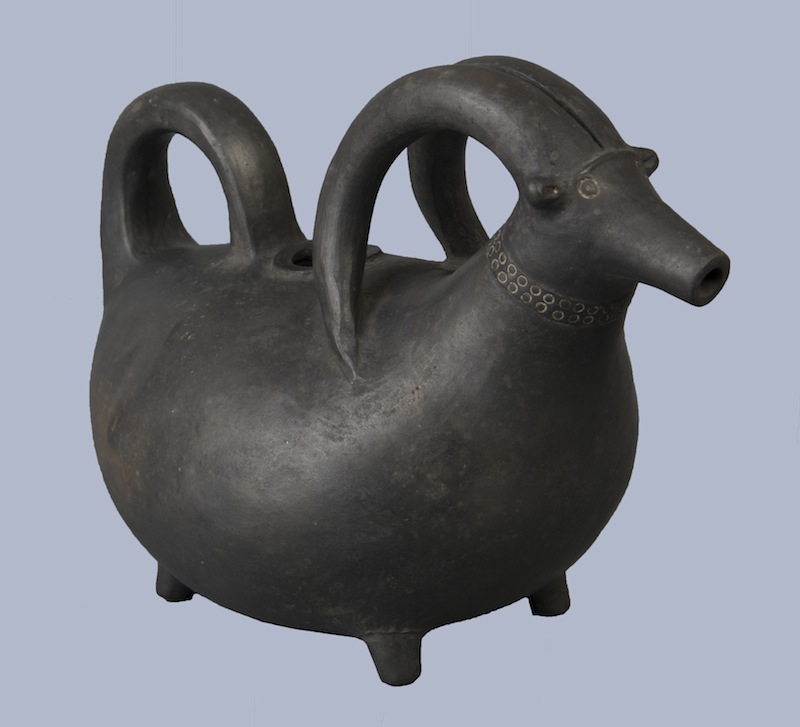Travelling to Gordion in 1950, scholars from the University of Pennsylvania Museum of Archaeology and Anthropology (Penn Museum) couldn’t have foreseen the treasures they would unearth. Seven years later, a team of archaeologists would behold an extraordinary sight inside Tumulus MM (Midas Mound), the largest of Gordion’s man-made burial mounds: the skeleton of a king in what was left of a cedar coffin, surrounded by bronze bowls, serving vessels, wooden tables and food remains from an extensive funeral banquet, all in an excellent state of preservation.

A black polished goat jug (c 760 BCE) which was excavated from Tumulus P, the burial chamber of a royal child (Source: Museum of Anatolian Civilisations, Ankara)
Several spectacular objects from this tomb, sealed nearly 3,000 years ago, are currently on display at the Penn Museum, along with finds from other excavations in Gordion, best known as the capital city of ancient Phrygia. The Golden Age of King Midas exhibition is extraordinary not just because it presents these rare ancient artefacts but also because the majority of them will be travelling to the States for the first time – around 120 objects, like the charming goat jug above, are on special loan from four museums in Turkey. The aim is to tell the story of Midas, the very real, very powerful ruler of the Phrygian kingdom from circa 750–700 BCE.

Tumulus MM, with other tumuli in the background (Source: digitalGordion)
Readers in the Philadelphia area should jump at the chance to see these treasures in person – they can cast a spell, as I experienced during a trip to Gordion in the summer of 2006. While most memories of this group outing have faded and worn around the edges, some details remain radiant. It was a bright day, and there wasn't a cloud in the sky as we drove over the plains of central Anatolia. The incongruous mounds that dotted the landscape – tumuli, as we would later learn to call them – ironically injected a bit of life into the static scene.

The monumental wooden burial chamber in Tumulus MM. Dated to circa 740 BCE, it is the oldest known wooden building in the world. (Source: Penn Museum Gordion Archive, R Liebhart 2007)
What sticks in my mind the most, though, was our journey into the centre of the striking Tumulus MM, a dank, damp place unlike the site’s other excavation areas. One of the archaeologists from Penn excavation team led us down the dim tunnel into what is believed to be the tomb of Gordias, King Midas's father.

Upper part of the wooden tomb chamber with inscriptions visible on the beam to the left (Source: digitalGordion)
The tomb's wooden beams reminded me of those my father lovingly cares for in our centuries-old barn – except the beams in Tumulus MM are almost 3,000 years old. Their continued existence is staggering and did more to confirm the immeasurable quality of ancient history for me than anything before or since.
While it’s easy to focus solely on Tumulus MM, Gordion is a massive excavation site – about 2.5 miles wide – and there are other fascinating finds to marvel at. The exhibition will display a small section of the oldest known coloured pebble mosaic floor, originally found in the citadel building and dated to the late 9th century BCE.

A watercolour by Joseph Last (1956) of the coloured pebble mosaic floor inside the citadel at Gordion. A portion of the mosaic will be on dispay at Penn Museum. (Source: Penn Museum Gordion Archive)
Visitors can also see fragments – and remarkable watercolour recreations by the renowned archaeological illustrator Piet De Jong – of the famous ‘Painted House’, built about 500 BCE and excavated in Gordion’s citadel during the 1950s. The murals in the ‘Painted House’ provide a rare glimpse into life in Gordion long after the death of King Midas.
The unprecedented collection of all these objects under one roof tells the broader story of a golden age presided over by a legendary king – it is the commemoration that King Midas and his capital city of Gordion deserve.
The exhibition runs from February 13 until November 27, 2016. It was realised in collaboration with the Republic of Turkey and with support from several individuals and institutions, including the Turkish Cultural Foundation.